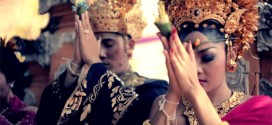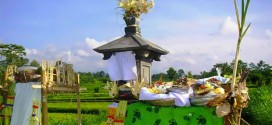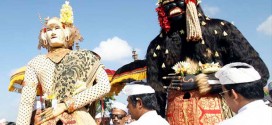Called Pis Bolong in Balinese and uang kepeng in Bahasa Indonesia, these living relics render a ceremony celebration incomplete without their presence. Ancient Chinese coins with square holes in the center and Chinese characters on the sides are all over in Bali.
Ancient Chinese coins with square holes in the center and Chinese characters on the sides are all over in Bali. Called pis bolong in Balinese and uang kepeng in Bahasa Indonesia, these living relics render a ceremony celebration incomplete without their presence.

Since the beginning of the world’s ‘Anno Domini’, the connection between Bali and China had begun. Among the many backdrops throughout the historical events, trading was the main reason. The Chinese presence had a great influence on Balinese culture and art. The relationship even led to the historical marriage between Sri Maharaja Aji Jayapangus, the King of Bali and Kang Cin Wei, a Chinese princess, in the year 12 A.D. This marriage justified the Chinese influence in Bali.
The story goes that Kang Cin Wei asked the king to have Chinese coins be a part of all rituals in Bali. As rituals are one of the most important things in Balinese life, Chinese coins followed suit and by then had already become part of the people’s monetary system – a phase shift from using the barter system.
The Europeans who came in the 17th Century did not change the Balinese practice of using Chinese coins, but they also used their own currency in trading. After the Indonesian independence and the Rupiah became the formal national currency, Chinese coins still remained in use in daily transactions. This is why the coins have a special function among the Balinese.
Gradually until 1970, when peoples’ awareness increased, they began to forego the Chinese coins in their economic life. But their purpose in rituals has lived on and on.
The presence of coins in rituals has become somewhat compulsory. Meanwhile, the stock of coins has seen a decrease. It is no wonder, for as the population grows more people conduct rituals and the demand for coins rockets sky-high. During certain rituals such as ngaben cremations or rituals for the butha kala or lower deities, the coins cannot be reused.
This increase has led to people making duplicates. The duplicates are far different from the original ancient Chinese coins. The sizes are smaller, they are thinner, and the Chinese characters have almost disappeared. These rough imitations can be found easily in traditional markets. The price is much cheaper than the original. People pay Rp. 1,500 per coin for the original, while they only pay Rp. 200 per coin for the imitation version.
The imitations are selling well in the market as many buy them because they have no choice. For some people, ‘cheap’ can be the main reason because in a small ritual in a small temple the number of coins needed may amount to thousands of rupiah. The amount for Chinese coin purchases can be among the ‘big buys’ in a ritual.
Using imitation coins in rituals however is not recommended. This problem has received special attention from the government. The Bali Cultural Office, as the representative of the government, formed the Bali Heritage Trust. The vision is to keep the cultural heritage pure. Their first pilot project was to make Chinese coins in Balinese versions. This project was launched in 2004 and has been facilitated by the United Nations of Social and Cultural Organization (UNESCO).
This took place in the village of Tojan in the Klungkung regency, where the factory and showroom is positioned together as UD Kamasan Bali. The factory mass-produces coins for rituals and accessories. The building has metal merging and forging in the basement, accessory creation on the top floor, and the showroom is in the front.
This factory makes different versions from the original Chinese coins, and the coins are produced by five different metals known as Panca Datu or ‘five strengths of life’. They include iron, silver, copper, gold, and bronze. Respectively, the materials have special meanings and potencies.
The Balinese characters also show special significance and strengths. They replace the Chinese characters that mostly note the issuing dynasty’s name. Nowadays, the words ‘Sa’, ‘Ba’, ‘Ta’, ‘A’ can be seen beside every side of the square center hole. Again, the four of them represent the strength in four corner points of the compass. Over the letters, a padma, the symbol of the holiness is depicted.
Its processing also incorporates a quite unique method of gathering household leftovers. I Made Sukma Swacita, the manager of UD Kamasan Bali, said that they have indeed gathered materials like broken taps, second-hand irons, etc. Apart from helping to clean the environment, they also did not want to depend on materials that were offered to the factory.
But how can second-hand things be used for sanctified ceremonies?
“We forge together all materials and then they become a new thing. Moreover, we also carry out penganugerahan ceremonies in Besakih and at the Ulun Danu Batur temple. Penganugerahan is a ceremony to ask for holiness and blessings for an object. In the beginning we used original Chinese coins. So now we ask divine permission to change it with these new Balinese coins,” said Sukma Swacita.
Swacita believes that the unique properties of the new coins can motivate people to use it in their rituals. Besides, the price is cheaper, only Rp. 750 per coin. And now the coins have been recommended for use by banten or ritual necessity makers and priests. The socialization has been carried already since several years ago.
For certain people, Chinese coins have special meanings and purposes. They believe that coins possess divine powers, namely the coins with special symbols or inscriptions. The symbols were believed to have powers related to a leading wayang (legendary epic) figure. For example, coins with the Rejuna (Arjuna) markings will bestow its holder with Arjuna-like agility and charm.
When asked for confirmation about the rumor, Sukma Swacita just laughed. Coins are only normal objects. It will contain powers only if filled with powers through certain rituals. UD Kamasan Bali also produces these kinds of “magical coins.” “But the bequeathing of power is not our responsibility.”
He showed some of his other accessories such as statues made from coins. A statue of Bhatara Rambut Sedana is worshipped as the God of Wealth. If given a special ritual, then the statue can be used for worship. But if it is not, it will still only be a statue, used for decorative purposes.
Today, many people are already using the Balinese versions of the Chinese coins. Despite this, its presence is not suddenly a shift from the real Chinese coins. It is already four years passed but in many rituals Chinese coins can still be found




